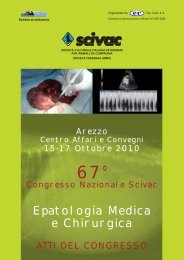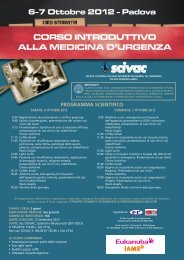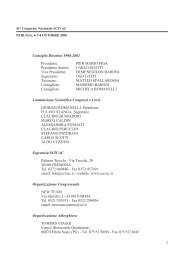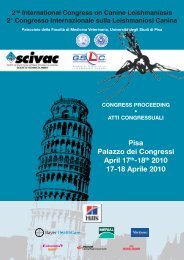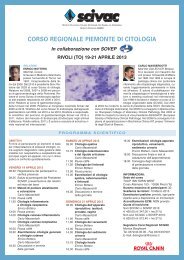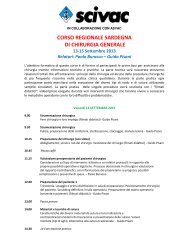58° Congresso Nazionale SCIVAC: Oncologia veterinaria
58° Congresso Nazionale SCIVAC: Oncologia veterinaria
58° Congresso Nazionale SCIVAC: Oncologia veterinaria
You also want an ePaper? Increase the reach of your titles
YUMPU automatically turns print PDFs into web optimized ePapers that Google loves.
58° <strong>Congresso</strong> <strong>Nazionale</strong> <strong>SCIVAC</strong> • Milano, 7-9 Marzo 2008 • <strong>Oncologia</strong> <strong>veterinaria</strong> - Alle soglie del III Millennio<br />
can be clearly advanced as “best” in the treatment of the various diseases that<br />
fall under the heading of lymphoma. A variety of chemotherapy protocols are<br />
available for the treatment of canine lymphoma. In establishing an optimal<br />
protocol, one must take into account the efficacy (as determined by remission<br />
and survival times), toxicity, and cost of therapy. Successful therapy with single<br />
agents can be achieved for lymphoma patients. However, single agent remissions<br />
tend to be short due to the rapid evolution of drug resistance mechanisms.<br />
Drugs that have been shown to have single agent efficacy in canine<br />
lymphoma include: corticosteroids, cyclophosphamide, L-asparaginase,<br />
doxorubicin (Adriamycin), epirubicin, mitoxantrone, actinomycin D, and<br />
CCNU (Lomustine).<br />
COMBINATION CHEMOTHERAPY<br />
COP<br />
Most chemotherapy protocols currently in use for lymphoma are based on<br />
the combination cyclophosphamide, vincristine (oncovin) and prednisone (COP<br />
therapy). These drugs are given either concurrently or in sequential weeks. Median<br />
remission times of around 6 months can be expected for most lymphoma<br />
dogs using a COP protocol alone. Side effects may include leukopenia, alopecia,<br />
gastrointestinal upset, sterile hemorrhagic cystitis (cyclophosphamide) and<br />
the typical adverse effects of prednisone therapy. This combination can be economically<br />
reasonable, as vincristine is available in generic form.<br />
Rotating sequential protocols<br />
Variations on the COP protocol contain additions of drugs such as l-asparaginase,<br />
cytosine arabinoside, methotrexate, and/or doxorubicin. In one popular<br />
protocol advanced by the Animal Medical Center, and modified at the University<br />
of Wisconsin, Madison, a rotating sequential combination of vincristine, L-<br />
asparaginase, prednisone, cyclophosphamide, doxorubicin, and methotrexate<br />
was used. Some of the best chemotherapy responses to date have been reported<br />
using this protocol, with 80% of patients attaining a remission (this is comparable<br />
to that achieved by COP therapy alone), and with median survival times<br />
extending past 12 months. 25% of dogs treated with this protocol have been reported<br />
to live more than 2 years. These findings were confirmed in a study of<br />
55 dogs at the University of Wisconsin, in which 84% achieved a complete response,<br />
with median remission duration of 36 weeks and 25% of dogs alive at<br />
2 years. Overall median survival time for this group was 51 weeks. This same<br />
83



